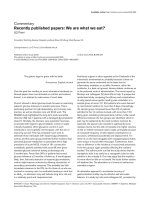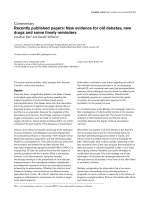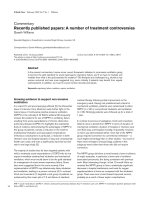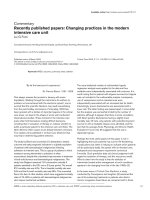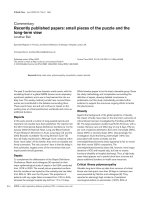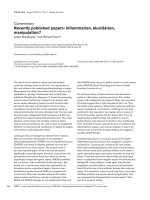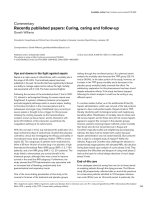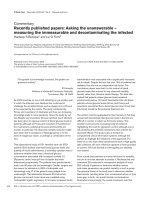Báo cáo y học: "Recently published papers: Renal replacement therapy: which route and how much? Intracerebral haematomas: does the size matter? β blockers and steroids: will we ever know" doc
Bạn đang xem bản rút gọn của tài liệu. Xem và tải ngay bản đầy đủ của tài liệu tại đây (47.89 KB, 3 trang )
Page 1 of 3
(page number not for citation purposes)
Available online />Abstract
Femoral access for renal replacement therapy appears to have a
similar infection rate to jugular access. High-intensity renal support
does not seem to improve mortality or length of hospital stay.
Acute kidney injury as defined by Acute Kidney Injury Network
predicts increased hospital mortality. Recombinant factor VIIa
reduces growth of volume of intracerebral haematoma but does
not affect clinical outcome. Sustained released metoprolol reduces
perioperative cardiac events in non-cardiac surgery but leads to
more deaths and strokes. Steroids are probably not beneficial in
either children with non-Haemophilus influenzae type b bacterial
meningitis, or in prophylaxis of acute respiratory distress syndrome
(ARDS), but could be beneficial in the treatment of ARDS.
Renal replacement therapy and acute kidney
injury: route and intensity
Parienti and co-workers [1] examined the effect of different
catheter insertion sites for acute renal replacement therapy
on the incidence of infection. Based on earlier findings, they
hypothesized that use of the jugular site would reduce
nosocomial events. The results of their randomized trial of
750 patients showed this was not the case. The rate of
catheterization colonization with femoral access was com-
parable to that seen with jugular access: 40.8 versus 35.7
per 1,000 catheter-days (p = 0.31). Body mass index (BMI),
however, did influence the association. In subjects with a BMI
greater than 28.4, use of jugular rather than femoral access
cut the risk of catheter colonization by 60% (p < 0.001). With
a BMI under 24.2, however, the opposite was true - jugular
catheterization increased the risk by 110% (p = 0.017). The
incidence of haematomas was also higher in the jugular
access group: 3.6% versus 1.1% (p = 0.03).
A paper by Palevsky and co-workers [2] explored the optimal
intensity of renal replacement therapy. Critically ill patients
with acute kidney injury (defined as either injury or failure by
the RIFLE criteria [3]) combined with either sepsis or
additional dysfunctional organ systems were randomized to
two renal replacement therapy intensity regimens. The high-
intensity strategy consisted of intermittent haemodialysis and
sustained low-efficiency dialysis 6 times per week and con-
tinuous venovenous haemodiafiltration at 35 ml/kg/h. The
lower-intensity strategy involved thrice-weekly haemodialysis/
sustained low-efficiency dialysis and continuous venovenous
haemodiafiltration at 20 ml/kg/h. There was no difference in
60-day mortality between the two groups of 1,124 patients,
and no difference in rates of recovery of renal function or
prevention of other organ dysfunction. However, the inciden-
ces of hypotension and electrolyte disturbances were higher,
and the duration of renal replacement therapy and hospital
stay were longer in the patients in the high-intensity group.
Factor VII for acute intracerebral haemorrhage
Following encouraging results from their phase 2 trial [4],
Mayer and colleagues reported somewhat disappointing
results from their definitive phase 3 trial on efficacy and safety
of activated recombinant factor VII (rFVIIa) for acute
intracerebral haemorrhage [5]. In this trial, 841 patients with
acute intracerebral bleed were randomly assigned to receive
placebo, 20 μg/kg or 80 μg/kg of rFVIIa within 4 hours of the
onset of stroke. No significant difference was found between
groups for poor clinical outcome (severe disability or death),
which was the primary endpoint of the study. In fact, more
patients in the 80 μg/kg group had poor outcome than
patients in the 20 μg/kg or placebo groups - 29%, 26% and
24%, respectively, although that was not statistically
significant. Also, more patients in the 80 μg/kg group had
serious thromboembolic arterial events compared to the
placebo group (9% versus 4%, p = 0.04). Despite this, they
showed that the growth of volume of intracerebral
haemorrhage was reduced by 3.8 ml (95% confidence inter-
val (CI) 0.9 to 6.7; p = 0.009) in the group receiving
80 μg/kg.
Commentary
Recently published papers: Renal replacement therapy: which
route and how much? Intracerebral haematomas: does the size
matter?
ββ
blockers and steroids: will we ever know?
Vlad Kushakovsky and Richard Venn
Department of Critical Care, Worthing Hospital, Lyndhurst Road, Worthing BN11 2DH, UK
Corresponding author: Vlad Kushakovsky,
Published: 14 August 2008 Critical Care 2008, 12:172 (doi:10.1186/cc6968)
This article is online at />© 2008 BioMed Central Ltd
ARDS = acute respiratory distress syndrome; BMI = body mass index; CI = confidence interval; HR = hazard ratio; rFVIIa = recombinant factor VII.
Page 2 of 3
(page number not for citation purposes)
Critical Care Vol 12 No 4 Kushakovsky and Venn
In the accompanying editorial [6], Dr Tuhrim comments that
several lessons can be learned from this trial. Firstly, the dose
of rFVIIa of less than 80 μg/kg is ineffective. Secondly, doses
larger than 80 μg/kg increase arterial thrombotic events
without a corresponding decrease in haematoma growth. And
finally, accomplishing a physiological goal may not necessarily
lead to improvement in meaningful clinical outcome.
POISE’d or not?
An eagerly awaited POISE trial has finally been published [7].
The main objective of this multicentre randomized controlled
trial was to investigate the effects of perioperative β blockade.
In this trial, 8,351 patients with, or at risk of, atherosclerotic
disease were randomly assigned to receive either extended-
release metoprolol succinate or placebo started 2 to 4 hours
before non-cardiac surgery and continued for 30 days.
The results showed that for every 1,000 patients undergoing
non-cardiac surgery, extended-release metoprolol would
prevent 15 myocardial infarctions, 3 cardiac revascularization
procedures, and 7 new cases of atrial fibrillation. However, that
would be at the cost of 8 excess deaths, 5 strokes, 53 cases of
clinically important hypotension, and 42 cases of bradycardia.
The authors suggested that current perioperative guidelines
recommending beta-blockers to patients undergoing non-
cardiac surgery should reconsider their recommendations in
light of the significant risks associated with the use of peri-
operative metoprolol.
In the accompanying editorial [8], Dr Fleisher and Dr
Poldermans suggest that a lower dose of a beta blocker -
started a week before surgery rather than the 2 to 4 hours
before, as in POISE - may still help. This editorial, however,
was heavily criticised by Dr London in his editorial [9], mostly
because both of the authors were heavily involved in writing
guidelines for the perioperative β blockade, and also because
their opinion was almost entirely based on the DECREASE
series [10] by Poldermans and colleagues, which were
“mainly observational, done primarily only on vascular surgery
patients and in only one country in the world”. However,
patients in these series were predominantly undergoing major
vascular surgery and had documented wall motion abnormali-
ties on dobutamine stress ECHO, and, therefore, could possibly
be considered higher risk than patients in the POISE study.
Steroids for meningitis and acute respiratory
distress syndrome
The study by Mongelluzzo and co-workers [11] aimed to
evaluate the relationship of adjuvant corticosteroid treatment
with mortality and length of hospitalisation in children with
bacterial meningitis.
The clinical setting was 27 tertiary care children’s hospitals in
the US where Haemophilus influenzae type b meningitis is
no longer prevalent. Between January 2001 and December
2006, a total of 2,780 children were discharged with
bacterial meningitis as their primary diagnosis from these
hospitals. Data regarding these hospitalisations were
obtained and analysed. Propensity-adjusted Cox proportional
hazards regression models stratified by age subgroups were
used to analyse endpoints of time to death and time to
hospital discharge.
Adjuvant corticosteroids (dexamethasone, hydrocortisone, or
methylprednisolone intravenously on the first day of hospitali-
sation) were used in 248 children (8.9%). The overall mortality
rate was 4.2% (95% CI 3.5% to 5.0%), with a cumulative
incidence of 2.2% at 7 days and 3.1% at 28 days after
admission. Adjuvant corticosteroid therapy was not associated
with reduced mortality in any age group. The hazard ratio (HR)
for children younger than 1 year was 1.09 (95% CI 0.53 to
2.24); the HR for children aged 1 to 5 years was 1.28 (95% CI
0.59 to 2.78); and the HR for children older than 5 years was
0.92 (95% CI 0.38 to 2.25). Adjuvant corticosteroid use was
also not associated with time to hospital discharge.
Limitations of the study include insufficient power to deter-
mine a difference in mortality with low case fatality rates and
possibly unreliable discharge diagnosis. A prospective rando-
mised controlled trial is necessary to determine the effect of
steroids on mortality in children with bacterial meningitis.
The question of steroid use in acute respiratory distress
syndrome (ARDS) has been a matter of hot debate for some
years. The topic has again been revisited in a recent meta-
analysis by Peter and colleagues [12]. The authors identified
nine randomised trials. When administered before the onset
of ARDS in four trials, steroids increased both the odds of
developing ARDS (odds ratio 1.55, 95% credible interval
0.58 to 4.05) and subsequently dying from ARDS (odds ratio
1.52, 95% credible interval 0.30 to 5.94). Note that credible
intervals crossed 1 and thus could not exclude a null effect.
However, when corticosteroids were administered for estab-
lished ARDS (five trials) they seemed to decrease mortality
(odds ratio 0.62, credible interval 0.23 to 1.26) and increase
number of days off mechanical ventilation. Although the
probability of a positive effect was high (93.2%), a null
hypothesis could not be excluded.
As Adhikari and Scales pointed out in the accompanying
editorial [13] “… for most doctors without strong prior beliefs,
this systematic review provides moderately strong evidence
for avoiding prophylactic corticosteroids in ARDS, and weak
evidence for their therapeutic use. Such doctors will view
these results as hypothesis generating and will await results
of additional trials.” Indeed, a multicentre, well-designed trial
is probably long overdue.
Competing interests
The authors declare that they have no competing interests.
Page 3 of 3
(page number not for citation purposes)
References
1. Parienti JJ, Thirion M, Mégarbane B, Souweine B, Ouchikhe A,
Polito A, Forel JM, Marqué S, Misset B, Airapetian N, Daurel C,
Mira JP, Ramakers M, du Cheyron D, Le Coutour X, Daubin C,
Charbonneau P; Members of the Cathedia Study Group: Femoral
vs jugular venous catheterization and risk of nosocomial
events in adults requiring acute renal replacement therapy: a
randomized controlled trial. JAMA 2008, 299:2413-2422.
2. The VA/NIH Acute Renal Failure Trial Network: Intensity of renal
support in critically ill patients with acute kidney injury. N Engl
J Med 2008 0:NEJMoa0802639.
3. Ostermann M, Chang RW: Acute kidney injury in the intensive
care unit according to RIFLE. Crit Care Med 2007, 35:1837-
1843, 1852.
4. Mayer SA, Brun NC, Begtrup K, Broderick J, Davis S, Diringer
MN, Skolnick BE, Steiner T; the Recombinant Activated Factor VII
Intracerebral Hemorrhage Trial Investigators: Recombinant acti-
vated factor VII for acute intracerebral hemorrhage. N Engl J
Med 2005, 352:777-785.
5. Mayer SA, Brun NC, Begtrup K, Broderick J, Davis S, Diringer
MN, Skolnick BE, Steiner T; the FAST Trial Investigators: Efficacy
and safety of recombinant activated factor VII for acute intrac-
erebral hemorrhage. N Engl J Med 2008, 358:2127-2137.
6. Tuhrim S: Intracerebral hemorrhage - improving outcome by
reducing volume? N Engl J Med 2008, 358:2174-2176.
7. POISE Study Group: Effects of extended-release metoprolol
succinate in patients undergoing non-cardiac surgery (POISE
trial): a randomised controlled trial. Lancet 2008, 371:1839-
1847.
8. Fleisher LA, Poldermans D: Perioperative
ββ
blockade: where do
we go from here? Lancet 2008, 371:1813-1814.
9. London MJ: Quo vadis, perioperative beta blockade? Are you
“POISE’d” on the brink? Anesth Analg 2008, 106:1025-1030.
10. Poldermans D, Bax JJ, Schouten O, Neskovic AN, Paelinck B,
Rocci G, van Dortmont L, Durazzo AE, van de Ven LL, van
Sambeek MR, Kertai MD, Boersma E; Dutch Echocardiographic
Cardiac Risk Evaluation Applying Stress Echo Study Group:
Should major vascular surgery be delayed because of preop-
erative cardiac testing in intermediate-risk patients receiving
beta-blocker therapy with tight heart rate control? J Am Coll
Cardiol, 2006, 48:964-969.
11. Mongelluzzo J, Mohamad Z, Ten Have TR, Shah SS: Corticos-
teroids and mortality in children with bacterial meningitis.
JAMA 2008, 299:2048-2055.
12. Peter JV, John P, Graham PL, Moran JL, George IA, Bersten A:
Corticosteroids in the prevention and treatment of acute res-
piratory distress syndrome (ARDS) in adults: meta-analysis.
BMJ 2008, 336:1006-1009.
13. Adhikari NKJ, Scales DC: Corticosteroids for acute respiratory
distress syndrome. BMJ 2008, 336:969-970.
Available online />

